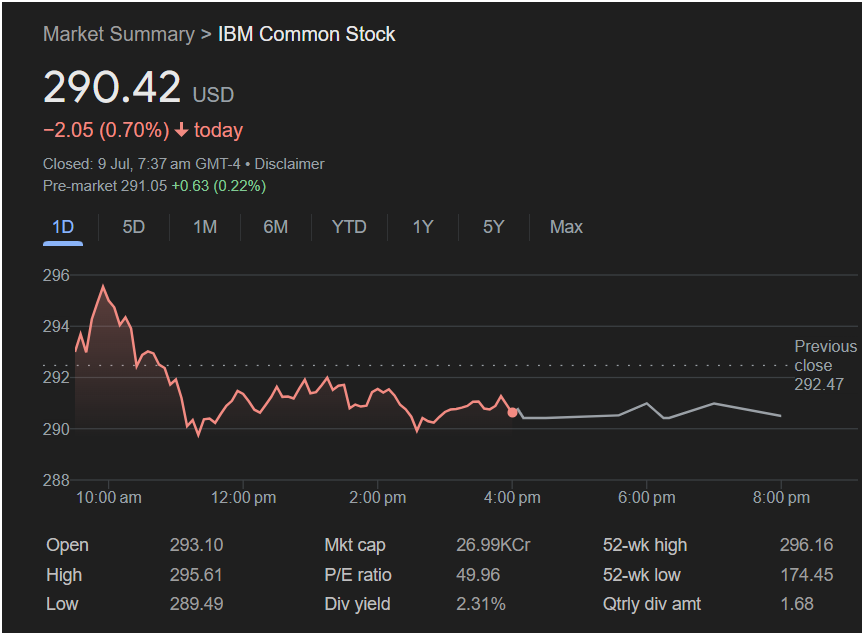The Battle for IBM’s Soul: A Deep Dive into a Titan’s Tumultuous Day at the Summit

For over a century, International Business Machines Corp. (NYSE: IBM) has been a byword for technological might and corporate gravitas. “Big Blue,” the unshakeable titan of enterprise computing, has navigated seismic shifts in technology, from punched cards to mainframes to personal computers. Yet, in the modern era, it has been a company more associated with legacy and slow-moving turnarounds than with breathless growth. The stock market screenshot from this particular trading day, however, tells a profoundly different, and far more dramatic, story. A closing price of $290.42, down $2.05 (0.70%), seems on its face like a mundane event. But this single day’s performance, when dissected, reveals a fierce and existential battle for the very soul of IBM—a conflict between its storied past and its ambitious future, fought in real-time on the volatile battlefield of Wall Street.
This is not a simple story of a minor loss. It is a narrative of a company at a dizzying peak, trading tantalizingly close to a 52-week high after a monumental rally. It is the story of a stock whose valuation metrics present a stunning paradox: a Price-to-Earnings ratio of nearly 50, screaming “hyper-growth,” coexisting with a robust dividend yield of over 2.3%, whispering “stable value.” The day’s trading chart itself is a dramatic vignette—a surge of morning optimism that brought the stock to the brink of a new high, followed by a brutal rejection and a sharp sell-off. It was a day the market tried to anoint the “new” IBM, only to have the ghosts of the “old” IBM pull it back from the precipice.

Chapter 1: The Anatomy of a Rejection – A Failed Assault on the Peak
A stock chart is more than a line on a screen; it is a fever chart of market sentiment. The intraday chart for IBM on this day tells a story not of simple weakness, but of a failed offensive—a day that began with a charge, only to end in a tactical retreat. It was a day that perfectly captured the market’s deep-seated ambivalence about IBM’s transformation.
1.1 The Morning Charge: A Surge Towards a New High (10:00 AM)
The day did not start with the negativity that would later define it. IBM opened at $293.10, comfortably above the previous day’s close of $292.47. This opening strength was immediately amplified. In the first 30 minutes of trading, the stock embarked on a powerful rally, surging to the day’s high of $295.61.
This high point is the most critical detail of the entire trading day. When compared to the 52-week high of $296.16, it reveals the true drama of the moment. The stock had rallied to within a mere 0.18% of its highest price in a year. This was a direct assault on a key resistance level. In the world of technical analysis, a breakout to a new 52-week high is a powerfully bullish signal, often suggesting the start of a new leg up as it attracts momentum traders and confirms the positive trend. The bulls were attempting to make a definitive statement: the IBM turnaround is real, the rally has momentum, and new highs are ahead. This morning surge was fueled by all the optimism surrounding the “new IBM” narrative—its success in hybrid cloud, its renewed push in AI, and its escape from the low-growth businesses of its past.
1.2 The Reversal at the Summit: The Bears Emerge from the Shadows (10:30 AM – 12:00 PM)
At the very moment of peak optimism, just pennies away from a new high, the tide turned with brutal efficiency. The advance was not just halted; it was violently reversed. The chart shows a sharp, V-shaped peak followed by a precipitous decline. This is the unmistakable signature of a market hitting a wall of selling pressure.
What happened at $295.61? The “old IBM” narrative reasserted itself. The skeptics, the profit-takers, and the short-sellers who have doubted IBM for years saw this rally to the peak as an unmissable opportunity. Their thinking was likely a cocktail of concerns:
-
Valuation Anxiety: With a P/E ratio approaching 50, many investors would have viewed the stock as fundamentally overvalued, regardless of the turnaround story. The rally to a new high was the perfect moment to cash in.
-
Historical Precedent: IBM has had false dawns before. Investors with long memories would be wary of getting caught in another “value trap.”
-
Technical Resistance: The 52-week high is a natural psychological barrier. Automated trading programs are often set to sell at or near such levels, adding to the selling pressure.
The result was a cascade. The initial rejection triggered more selling, which pushed the price down through the opening level and then through the previous day’s close. The stock plummeted from its high of $295.61 to its low of $289.49 just before noon—a stunning intraday reversal of over $6 per share, or more than 2%. The morning’s bullish charge had been decisively repulsed.
1.3 The Midday Stalemate: A Grinding Search for a Floor (12:00 PM – 4:00 PM)
After the dramatic morning sell-off, the stock entered a period of choppy, sideways consolidation. The sharp decline found a floor around the $290 level, suggesting that a new set of buyers—perhaps value-oriented investors attracted by the intraday dip—stepped in to absorb the selling pressure.
The afternoon was a grinding war of attrition. The chart shows a series of small rallies and pullbacks, with the stock unable to mount any meaningful recovery but also unwilling to break down to new lows. This sideways “grind” is indicative of a market in equilibrium, but a tense one. The morning’s sellers had exhausted their immediate firepower, but the buyers lacked the conviction to drive the price back up. The stock was trapped in a range, wounded from the morning’s battle. The close at $290.42 was well off the day’s lows, but the psychological damage was done. The attempt to break out had failed, and the day ended with a clear victory for the bears.
1.4 The After-Hours and Pre-Market Murmurs
The activity after the 4:00 PM close, depicted by the thin grey line, was muted, hovering around the closing price. However, the screenshot provides a hopeful clue for the bulls in the form of the pre-market data for the following day: “Pre-market 291.05 +0.63 (0.22%)”. This small gain suggests that the immediate panic had subsided overnight and that some stability was returning. It was not a roaring comeback, but it indicated that the $290 level was holding, for now. The battle for IBM’s future direction was over for the day, but the war was set to resume, with the key resistance at the $296 level now looking more formidable than ever.
Chapter 2: The Colossus in Transition – A Century of Reinvention and a Decade of Doubt
To understand the intense drama of this single trading day, one must appreciate the immense weight of IBM’s history. This is a company that has, for over 100 years, been a barometer of American technological and economic power. Its journey has been one of dominant peaks and painful valleys, and its current state is the culmination of a decade-long struggle to escape its own legacy.
2.1 The Architect of the Information Age
Founded in 1911, IBM’s history is, in many ways, the history of computing. From its early dominance in tabulating machines to the development of the revolutionary System/360 mainframe in the 1960s, IBM effectively created the enterprise computing market. It was the company that sold not just machines, but solutions, building impenetrable relationships with the world’s largest corporations and governments. Its “Big Blue” moniker, its army of white-shirted salesmen, and its reputation for reliability made it one of the most respected and powerful companies on Earth. It even ushered in the personal computer era with the IBM PC in 1981, though it would ironically lose control of the very market it legitimized to its suppliers, Microsoft and Intel.
2.2 The “Lost Decades”: Grappling with Disruption
The late 1980s and 1990s brought IBM to the brink of collapse. The shift from centralized mainframes to distributed client-server computing and then to the internet caught the giant flat-footed. Under CEO Lou Gerstner in the 90s, the company was saved from being broken up and was successfully refocused on services and software. However, the 21st century brought new waves of disruption that IBM struggled to navigate.
The rise of cloud computing, pioneered by Amazon Web Services, was a direct assault on IBM’s traditional business of selling and managing on-premise hardware and software. The explosion of mobile computing and consumer tech, led by Apple and Google, left IBM looking slow and out of touch. Under CEOs Sam Palmisano and Ginni Rometty, the company pursued a strategy focused on “strategic imperatives” like cloud, analytics, mobile, and security. It made significant investments, most notably in its Watson AI platform.
However, for much of the 2010s, IBM was perceived by Wall Street as being in a state of managed decline. While the strategic imperatives grew, the legacy businesses were shrinking faster, leading to years of stagnant or declining overall revenue. The stock became a “value trap”—seemingly cheap but unable to generate meaningful growth, a frustrating holding for all but the most patient dividend investors.
2.3 The Krishna Era: The Radical Surgery
The appointment of Arvind Krishna as CEO in 2020 marked a definitive break from the past. Krishna, the chief architect of IBM’s cloud strategy and the driving force behind its most important acquisition, immediately initiated a radical transformation. His strategy was built on two audacious moves:
-
The Red Hat Acquisition: In 2019, while Krishna was head of Cloud and Cognitive Software, IBM made a stunning $34 billion bet to acquire Red Hat, a leader in open-source software. This was not just a large acquisition; it was the linchpin of IBM’s entire future strategy. Red Hat’s OpenShift platform was the key to unlocking the Hybrid Cloud market.
-
The Kyndryl Spin-Off: In 2021, Krishna made the bold decision to cleave the company in two, spinning off its massive but low-growth, low-margin Managed Infrastructure Services division into a new public company called Kyndryl. This was a painful but necessary surgery. It instantly removed nearly $19 billion in low-quality revenue from IBM’s books, allowing the “new” IBM to focus exclusively on the high-growth, high-margin opportunities in Hybrid Cloud and AI.
It is this “new,” post-spin-off IBM that has captured the market’s imagination over the past year. The rally from the 52-week low of $174 to the high of $296 is the market’s vote of confidence in Krishna’s bold strategy. The day’s trading action is the market’s hesitation, asking the crucial question: has the surgery truly worked?
Chapter 3: Decoding the Dashboard – The Startling Paradox of a Growth-Value Hybrid
The financial metrics on the screenshot are where the story of IBM’s identity crisis comes into sharp focus. The numbers present a fascinating, almost schizophrenic, profile of a company that is being valued by the market as both a speculative growth play and a stable income stock simultaneously.
3.1 Market Cap: 26.99KCr – The Enduring Scale
The notation “26.99KCr” (26,990 Crore INR) points to a very large market capitalization. At the time this screenshot was likely taken, IBM’s market capitalization was in the range of
270 billion. While this is smaller than tech behemoths like Microsoft or Apple, it still places IBM among the largest and most significant technology companies in the world. This scale grants it immense resources, a global salesforce, deep enterprise relationships, and a powerful brand. However, it also makes the company a massive ship that is notoriously difficult to turn quickly. This scale is both a great asset and a great liability in its transformation efforts.
3.2 P/E Ratio: 49.96 – The Shock and Awe Valuation
This is, without question, the most astounding number on the dashboard. A Price-to-Earnings ratio of nearly 50 for IBM is a radical departure from its historical valuation. For most of the past decade, IBM traded at a “value” P/E multiple, often in the low teens (10-15). A P/E of 50 is a valuation typically reserved for high-octane, disruptive growth companies, not 110-year-old industrial giants.
What can explain this dramatic re-rating?
-
A Bet on Future Growth: The market is no longer valuing IBM on its past or even its current earnings. A P/E of 50 is a powerful forward-looking statement. It signals a belief that the combination of Hybrid Cloud and AI monetization is about to trigger a massive acceleration in IBM’s earnings growth, which will, in turn, rapidly lower the P/E ratio in the future.
-
The Post-Spin-Off Effect: The shedding of the low-margin Kyndryl business fundamentally improved the quality and growth profile of IBM’s remaining earnings. The “new” IBM is a more focused, higher-margin software and consulting company, and the market is assigning it a much higher multiple than the old, sprawling conglomerate.
-
Accounting Artifacts: It’s possible that the reported trailing “GAAP” (Generally Accepted Accounting Principles) earnings are temporarily depressed due to one-time costs associated with the spin-off, acquisitions, or other restructuring charges. This would make the denominator (“E”) in the P/E ratio artificially small and the resulting multiple artificially high. Many analysts would focus on “non-GAAP” or “adjusted” earnings, which would yield a more modest (though still elevated) P/E.
-
AI Hype: The explosion of interest in generative AI has lifted all boats. The market, seeing IBM’s renewed push with its watsonx platform, may be applying a generous “AI premium” to the stock, betting that it can become a key player in the enterprise AI space.
Regardless of the precise reason, a P/E of 50 makes IBM a high-stakes proposition. It means the company is priced for near-perfect execution. The failed rally on this day was a direct reflection of the market’s nervousness about this rich valuation.
3.3 Dividend Yield (2.31%) and Quarterly Dividend (1.68) – The Anchor of Value
In stark contrast to the speculative P/E ratio is the dividend. A quarterly dividend of
6.72 annually) results in a very healthy yield of 2.31%. This is the “old IBM” signal, and it’s a powerful one. IBM is a long-standing member of the “Dividend Aristocrats,” an elite group of S&P 500 companies that have increased their dividend for at least 25 consecutive years.
This dividend has several crucial implications:
-
Shareholder Commitment: It demonstrates a strong commitment to returning capital to shareholders and reflects management’s confidence in the company’s ability to generate stable, long-term cash flow.
-
A Different Investor Base: The dividend attracts a class of income-oriented investors, such as retirees and pension funds, who are less concerned with explosive growth and more focused on reliable income. This provides a solid base of demand for the stock.
-
A Valuation Floor: The dividend yield acts as a soft “floor” for the stock price. If the stock were to fall significantly, the yield would become even more attractive, drawing in new buyers and helping to stabilize the price.
The Paradox: The coexistence of a P/E of 50 and a dividend yield of 2.3% is the central tension of IBM’s stock. It is a growth stock and a value stock rolled into one. It is trying to be everything to everyone. The day’s trading showed this tension perfectly: the growth investors charged for the peak and got spooked by the valuation, while the value investors likely stepped in at the lows, attracted by the dividend.
3.4 52-Week Range: $174.45 – $296.16 – The Turnaround Takes Flight
The 52-week range graphically illustrates the success of the “new IBM” narrative over the past year. The rally of nearly 70% from the low to the high is a testament to the market’s growing belief in Arvind Krishna’s strategy. The stock has broken out of its decade-long slump and is finally being re-evaluated as a potential growth story. The day’s trading, occurring at the absolute peak of this incredible run, underscores why the rejection was so significant. It was the first major sign of doubt after a year of relentless optimism.
Chapter 4: The Strategic Battlefield – The High-Stakes Gambits in Hybrid Cloud and AI
IBM’s lofty valuation and its entire turnaround thesis rest on the successful execution of a highly specific, two-pronged strategy: dominating the Hybrid Cloud market and establishing itself as the go-to provider for enterprise-grade Artificial Intelligence. These are not just new products; they are IBM’s declared battlegrounds for its future.
4.1 The Hybrid Cloud Gambit: The “Switzerland” of the Clouds
Arvind Krishna has been clear: IBM is not trying to beat Amazon (AWS), Microsoft (Azure), and Google (GCP) in a head-to-head battle to be the biggest public cloud provider. That war has largely been fought. Instead, IBM’s strategy is far more subtle and, potentially, more lucrative. It aims to become the essential management layer that sits on top of all clouds.
This is the “Hybrid Cloud” thesis. The reality for most large enterprises is not that they use one cloud, but that they use many clouds (multi-cloud), in addition to their own on-premise data centers. This creates immense complexity in managing applications, data, and security across all these different environments.
This is where the Red Hat acquisition was so critical. Red Hat OpenShift is a containerization platform built on open-source technologies like Kubernetes. It allows companies to build, deploy, and manage applications once and then run them anywhere—on AWS, on Azure, on their own servers, or all of the above. IBM’s bet is that as this complexity grows, enterprises will desperately need a single, open platform to unify their IT infrastructure. IBM, with OpenShift, aims to be that platform—the “Switzerland” of the clouds, providing the essential software and consulting services to manage this new, complex world. The growth in IBM’s software and consulting segments is directly tied to the success of this strategy.
4.2 The AI Gambit: From Watson’s Hype to watsonx‘s Pragmatism
Artificial Intelligence has been part of IBM’s brand for decades, but its journey has been rocky. The original Watson, famous for winning the game show Jeopardy! in 2011, created enormous hype but largely failed to deliver on its promise as a commercial product. It was often seen as a monolithic, expensive, “black box” solution.
Under Krishna, IBM has completely rebooted its AI strategy with the launch of the watsonx platform. This new approach is far more pragmatic and aligned with the current generative AI boom. Instead of trying to be the sole provider of a single, all-knowing AI, watsonx is a platform designed to help businesses build, train, and deploy their own AI models, using a combination of IBM’s models, open-source models, and models from other companies.
The strategy focuses on key enterprise needs that consumer-facing tools like ChatGPT don’t address:
-
AI Governance: Providing tools to ensure that AI models are transparent, fair, and explainable, and that the data used to train them is properly sourced and managed—a critical requirement for regulated industries like finance and healthcare.
-
Data Sovereignty: Allowing companies to train and run AI models on their own data, wherever it resides (in any cloud or on-premise), without having to send sensitive information to a third party.
-
Targeted Use Cases: Focusing on specific business applications like code generation for modernizing mainframe applications, customer service automation, and cybersecurity.
This AI gambit is the “growth catalyst” that investors are betting on to justify the 50 P/E ratio. Its success hinges on convincing large corporations that IBM is the safest, most reliable partner for deploying AI at scale.
Chapter 5: The Weight of History and the Perilous Road Ahead
To be an investor in IBM is to be a student of both history and technology. The potential rewards of a successful transformation are immense, but the path is fraught with peril. The day’s failed rally was a stark reminder of the significant risks that still loom over Big Blue.
5.1 The Ever-Present Threat of Competition
IBM does not operate in a vacuum. Its chosen battlegrounds are also the primary focus of the world’s most powerful and aggressive technology companies.
-
In Hybrid Cloud: While IBM’s “Switzerland” strategy is clever, the hyperscalers are not standing still. AWS (with Outposts), Microsoft (with Azure Arc), and Google (with Anthos) are all developing their own powerful tools to extend their platforms into on-premise and multi-cloud environments. They are fierce competitors with deep pockets and vast engineering resources.
-
In AI: Every major tech company is in an all-out war for AI supremacy. Google, Microsoft (via its OpenAI partnership), and Amazon are integrating generative AI into every facet of their cloud platforms. A host of well-funded startups are also innovating at a furious pace. IBM must prove that its focus on governance and enterprise-grade reliability is a strong enough differentiator to win against these rivals.
5.2 Execution Risk and Cultural Inertia
A strategy is only as good as its execution. IBM’s challenge is twofold:
-
Integrating Red Hat: Fully integrating the fiercely independent, open-source culture of Red Hat into the more traditional, corporate culture of IBM without stifling its innovation is a monumental management challenge.
-
Overcoming Inertia: Transforming a 110-year-old company with hundreds of thousands of employees is like turning an aircraft carrier. Despite the new strategy, pockets of the old, slow-moving culture inevitably remain. IBM must continue to foster a culture of speed, agility, and customer focus to compete effectively.
5.3 The Peril of the High Valuation
As highlighted by the day’s trading, the stock’s own valuation has become a primary risk. The P/E of 50 leaves absolutely no room for error. The company is now under immense pressure to deliver quarter after quarter of accelerating growth. Any disappointment—a slight miss on revenue, weaker-than-expected guidance, or signs that AI monetization is taking longer than hoped—could trigger a brutal sell-off as the market’s lofty multiple contracts back towards a more historical norm.
A Single Day, A Century of Struggle
We return, finally, to the single screenshot. A 0.70% decline. A close of $290.42. A failed attempt to conquer the peak. In this simple snapshot, we see the entire epic saga of modern IBM playing out. It is a company straining to be reborn, to shed the skin of its past and embrace a future defined by the cloud and AI.
The morning rally to $295.61 was the sound of the market cheering for this rebirth. It was a vote of confidence in Arvind Krishna’s vision, in the transformative power of the Red Hat acquisition and the Kyndryl spin-off, and in the promise of watsonx. It was the market trying to believe in the P/E of 50.
The sharp reversal from that peak was the sound of a century of doubt and skepticism rushing back in. It was the weight of a decade of underperformance, the fear of another false dawn, and the rational anxiety about a valuation that seems to have gotten ahead of itself. It was the value investors, the dividend seekers, and the quiet skeptics reminding the market that this is still IBM—a massive, complex ship that has yet to definitively prove it can outmaneuver the nimble destroyers of the modern tech world.





